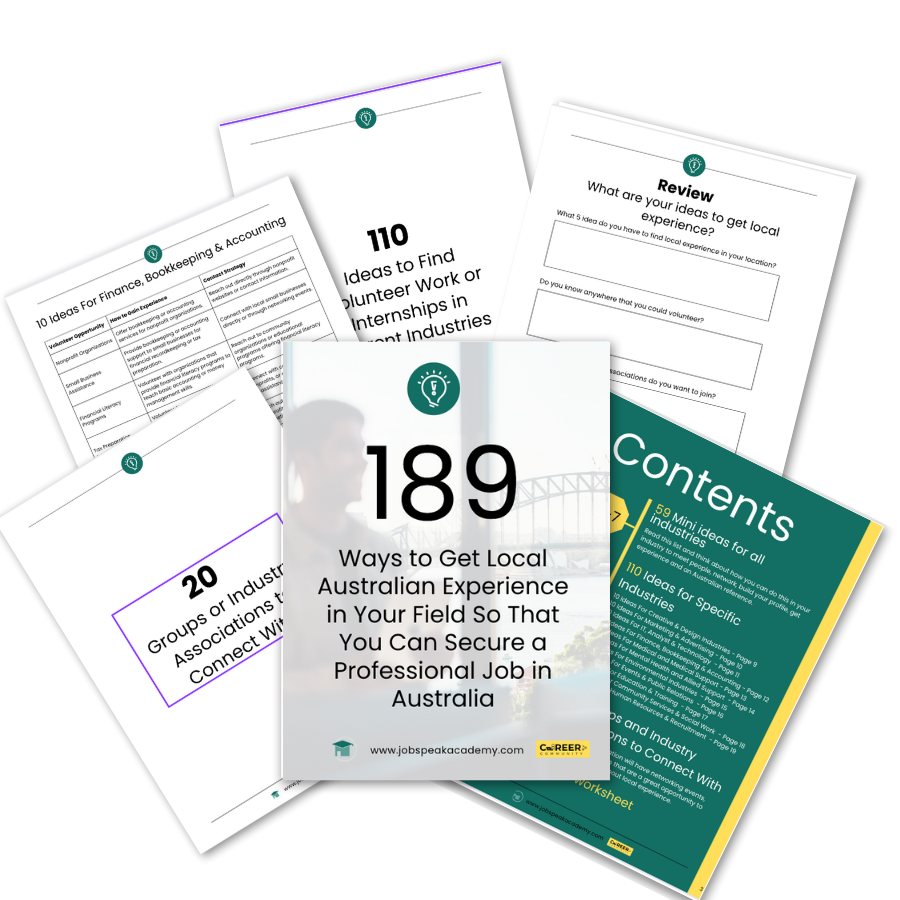This article was submitted to Insider Guides on behalf of Natalie Peart, Founder and English for Employment Coach at Jobspeak Academy
As an international student in Australia, finding a professional job after graduation can be both exciting and challenging.
In my experience, there is one skill that so many international students overlook, and it is being able to read a job advert properly.
Why do we need to read a job advert properly?
A job advert is a wish list. It includes all of the skills, strengths, experience and characteristics that an employer wants and you need to know all of this for every step of your job search journey.
Reason 1: You can use job adverts as a research tool to identify the essential skills in your industry so that you can include them in your resume and LinkedIn profiles.
Top tip – To do this read 4-5 job adverts and write down the common skills, characteristics and strengths they want. The ones that are most common should be on your resume.
Reason 2: You need to tailor your resume to every job that you apply for, (yes, every job) and that means that you need to read and understand exactly what an employer wants so you can include the skills on your resume.
Top tip – Employers want evidence that you can do the job. And so, you can’t just write “I have communication skills,” you have to tell them an example of when you used your communication skills. Remember that anyone can write down words but not everyone can prove that they have the skill.
Reason 3: You need to write a cover letter that addresses the selection criteria and speaks to the employer about the specific skills that they ask for in the job advert.
Top tip – Selection criteria are the list of skills, qualifications, characteristics and experience they want you to have. In your cover letter, you need to write about the EXACT things they want in a candidate. The most common reason an application gets rejected is that you submit a generic cover letter and it doesn’t tell the hiring manager that you can do the specific job that they are hiring for.
Reason 4: The interviewer will always ask questions about the skills and characteristics that they listed in the job advert.
Top tip – You can use the job advert to predict interview questions. If the job advert asks for you to have good relationship-building skills, problem-solving skills and time management skills then they will ask you a question about these skills. This will usually be a behavioural interview question where you must give an example of a time you used the skill.
As you can see, the job advert is essential to understand, they hold the key to understanding what employers are seeking in their ideal candidates. If you learn how to read a job advert in English you will stand out in the competitive job market in Australia because you will speak directly to the employer.
In this step-by-step guide, I am going to show you how to read a job advert so that you understand exactly what an employer wants at every stage of your job search journey. Whether you’re eyeing an internship, a part-time gig, or a fully-fledged professional role, the insights shared here will equip you with the tools to decode job advertisements effectively.
First, let’s remind ourselves about some reading techniques.
Reading techniques: Skimming and scanning
There are academic English reading strategies called skimming and scanning that I know you all know from your studies or any English tests you took before arriving in Australia. You can use the same strategies for reading job adverts.
When you skim read, you quickly read the information to get a gist of the text. Skimming is used to get a general idea of what the text is about and read the main ideas.
Scanning for information is when you read a text to find specific information.
So, how does this work when you are reading a job advert?
When you are skimming a text you will read the parts that are more likely to focus on the main ideas. For a job advert, you would skim-read the title, the headings and the essential criteria to get an overview of if you are qualified.
Scanning for information is a bit different because you are looking for specific details. We actually use the reading strategy, scanning for information most days, for example, when you are reading a menu at a café or when you are looking for a contact on your phone. You are looking for specific information.
When scanning a job advert, like other texts, you will be looking for keywords or phrases.
So, what is the key information in a job description?
- The company name
- The job location (is it a reasonable distance to travel to?)
- The job title
- The contact person (not all job adverts have one, but always look for this)
- What personal characteristics are they looking for?
- Essential requirements (specific skills, qualifications, number of years of experience) and desirable criteria*
- Application instructions (how should you apply for the role?)
*Essential criteria are things that you must possess, whereas desirable criteria are skills or traits that the employer would like, but would consider your application without them.
Step 1 – Understand the components of a job advert and identify what they want
Title and job position – Is the position the right level for you? Is it entry-level, mid-level or senior? Ensure that the level of responsibility fits your current situation.
Company overview – This is a helpful part because it usually talks about a company’s values, mission and culture. I always suggest that you mention the company values in your application so that they see that you also have the same values.
Job description – Read the job description to understand what day-to-day duties they want you to do and ensure that the tasks are written in your resume. So, if they say that the role includes “replying to emails, and phone calls in a high-pressure environment,” you need to speak about a time when you did this in the past, or, use transferable skills to highlight that you can do this.
Top tip – Don’t feel defeated if you don’t have everything they ask for in a job description. You only need about 65-70 per cent of the key requirements so always apply if you think you can do it, but focus on your transferable skills and what skills you gained from study, internships or casual jobs. Transferable skills are really valuable to an employer and they will be impressed that you know them.
Skills and competencies – This is where you need to look for keywords. You can copy and paste the job advert text to a text editor and highlight the keywords or you can print out the job advert and use a pen. Whatever is best for your learning style. But, you need to read carefully and understand the soft skills, hard skills, transferable skills, strengths, characteristics and experience that they want so that you can give them proof that you can do them.
Top tip – Here are some key expressions to look out for: “Must have the ability to” = they want to know what you can do this and “demonstrated experience in” or “proven experience in” = They want to know that you have done this before, and you should include specific examples.
Step 2 – Identify the key skills and think of examples of when you’ve used them
The strategy I suggest is to:
Print out the job advert or copy and paste it into a document and highlight or underline the key expectations of the role. Read it a few times to make sure that you have understood everything.
Then write down the key skills, experience, characteristics and qualifications that you’ve underlined in a notebook or a document. You need to prove that you have these and think of examples of when you used a skill that shows that you’re a great candidate, so what I suggest is that you mindmap. Start with the skill in the middle of the paper and then brainstorm memories from your experience or education when you’ve used the skill, once your brain starts to think of ideas it will remember lots of wonderful experiences that you have.
The more effort you put into reading a job advert and applying for a job the easier your interview will be. All of this research and planning will be valuable for your interview as well.
Step 3 – Use this super valuable research
The notes and mindmap and all the wonderful skills that you’ve brainstormed can be used to tailor your resume, write your cover letter and prepare for the interview. The more job adverts and resumes you tailor the easier it gets. You don’t have to do this every time but you do need to ensure you read it properly and confirm that you have written about the specific skills that they want.
Remember, employers are busy and they want to know that you can do the specific job that they’re recruiting for and this is the reason why you need to provide evidence. It is much better to spend the time on 1 really good application than 10 generic ones because the generic ones won’t get a response.
Investing time in mastering reading and understanding job advertisements is a strategic move for international students in Australia. These ads are more than mere listings; they’re the gateway to securing your dream job. By following the steps outlined in this guide, you’ll not only understand job requirements but also gain the insights needed to tailor your applications and show an employer why you’re the best candidate for the job.
Are you ready to begin your job search journey in Australia? Local experience is usually essential in so many industries. I created a guide that has 189 ideas to get local Aussie experience so you can begin your Australian career. You can download it below.






